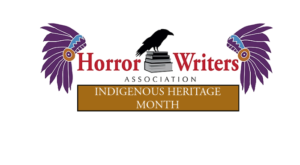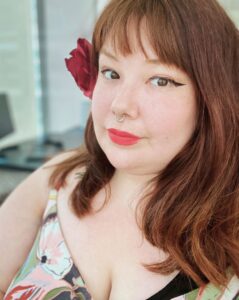Indigenous Heritage in Horror Month: Interview with Tiffany Morris
 Tiffany Morris is an L’nu’skw (Mi’kmaw) writer from Nova Scotia. She is the author of the swampcore horror novella Green Fuse Burning (Stelliform Books, 2023) and the Elgin Award-winning horror poetry collection Elegies of Rotting Stars (Nictitating Books, 2022). Her work has appeared in the Indigenous horror anthology Never Whistle At Night, as well as in Nightmare Magazine, Uncanny Magazine, and Apex Magazine, among others.
Tiffany Morris is an L’nu’skw (Mi’kmaw) writer from Nova Scotia. She is the author of the swampcore horror novella Green Fuse Burning (Stelliform Books, 2023) and the Elgin Award-winning horror poetry collection Elegies of Rotting Stars (Nictitating Books, 2022). Her work has appeared in the Indigenous horror anthology Never Whistle At Night, as well as in Nightmare Magazine, Uncanny Magazine, and Apex Magazine, among others.

What inspired you to start writing?
It’s always been easier for me to articulate my thoughts and feelings in metaphorical language, rather than directly. I think that’s why story is so important to people; why poetry resonates at times of uncertainty. My characters and poetry aren’t always a conduit for my experience but are an interesting way to explore the textures of consciousness and share them with others – it’s intimacy at a remove.
What was it about the horror genre that drew you to it?
I’ve always enjoyed horror – from the cartoonish to the existential, it’s such an interesting genre for exploring that which is hidden, suppressed, ignored. Horror is the lit candle revealing the language of the nightmare.
Do you make a conscious effort to include Indigenous characters and themes in your writing and if so, what do you want to portray?
I do! It’s important to me to have characters who reflect the realities of diversity out in the world. I’ve always really hungered for L’nuk (Mi’kmaw) representation, so my characters tend to be L’nuk. I also have a lot of working-class characters (though I wasn’t working-class growing up, it’s something that permeated my adulthood) and queer characters (I’m bisexual), for the same reason.
What has writing horror taught you about the world and yourself?
Writing horror has taught me that the ghosts you exorcise onto the page just make different apparitions appear in your doorway.
How have you seen the horror genre change over the years? And how do you think it will continue to evolve?
I think it’s become bigger and better than ever – there are so many voices telling different stories that there truly is something for everyone. I hope all of it gets weirder and more experimental because these are times of increasing connection and abstraction.
How do you feel the Indigenous community has been represented thus far in the genre and what hopes do you have for representation in the genre going forward?
There have always been awesome Indigenous horror writers, and I think the genre is starting to catch up to us! The growth is lovely to see – it shows the diversity that exists within Indigenous cultures in North America and globally, as well as the wonderful variety in style that exists from author to author. I hope that the wave continues well into the future.
Who are some Indigenous horror authors you recommend our audience check out?
I highly recommend the book Ghost Singer by Anna Lee Walters. Also recommend Shane Hawk, Richard Van Camp, Alicia Elliott, Nathan Adler, Jessica Johns, Eden Robinson, and really anyone in the Never Whistle at Night anthology!
What is one piece of advice you would give horror authors today?
You really don’t need to argue with each other about trigger warnings. Just use them or don’t.
And to the Indigenous writers out there who are just getting started, what advice would you give them?
Your voice matters – write in the way that speaks to you. Universality is not a compelling goal for creating art, and you’ll be surprised by what resonates with the audience in the end. Also, don’t listen to people who say there are too few of us to count: there are many of us, and we write because of those who came before us and for those who follow.
Wela’lin for this interview and wela’lioq to all who read it!



